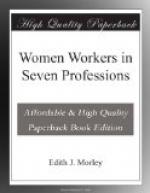The training for the examination of the Central Midwives’ Board is based on the method pursued in medical education in English-speaking countries, viz., there is not one uniform course, but each of the training schools attached to hospitals follows out its own plan of training, each hospital having been approved by the Central Midwives’ Board as giving an adequate training for its examination. There are now seven maternity hospitals in London, where women students may train in midwifery. Of these, only one—the Clapham Maternity Hospital (with its training school founded by Mrs Meredith in 1885)—is, and always has been, entirely officered by women. Here the course advised is six months, viz., three months in the hospital (Monthly Nursing), and three months in the hospital and district doing Midwifery proper. During this time over 200 cases may be seen, and nearly 100 cases attended personally. The cost of this training is L35 to L40, which includes board and residence for twenty-six weeks. Students previously trained elsewhere may take one months’ extra training at a cost of ten guineas. Private doctors and midwives may also take pupils if recognised as teachers by the Board.
Midwifery training is now required not only by those who are going to act as midwives, but also by most missionaries, all fully trained nurses (for matrons’ posts or colonial posts) and by health visitors and inspectors before obtaining appointments.
But it should be borne in mind, especially in considering the present condition and future prospects of Midwifery as a profession, that even now a large though ever-decreasing proportion of registered midwives are still ignorant women who have never passed the Central Midwives’ Board or any other examination, and have had no teaching from any one more experienced or better informed than themselves. For when the Midwives’ Act came into force in 1903, it was necessary to move slowly, and so a clause was inserted, permitting women who had been in bona-fide practice for more than one year before 1902 to continue their work under inspection and supervision (with many attempts at teaching them by means of simple lectures and demonstrations). This plan, or some similar one, was necessary, not only in the interests of the midwives themselves, a set of decent and kindly, if ignorant women, who would have been ruined by too sudden a change, but also because a large number of mothers in England would have been left with no one to help them in their time of need unless they were prepared to run the risk of breaking the law. This, until recently, respectable English women disliked to do.




